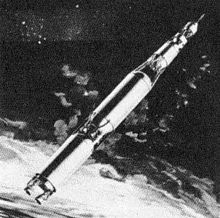 Proposed Saturn C-3 and Apollo configuration (1962) | |
| Function | LEO and Lunar launch vehicle |
|---|---|
| Manufacturer | Boeing (S-IB-2) North American (S-II-C3) Douglas (S-IV) |
| Country of origin | United States |
| Cost per launch | 43.5 million |
| Cost per year | 1985 |
| Size | |
| Height | 269.0 feet (82.0 m) |
| Diameter | 320 inches (8.1 m) |
| Mass | 2,256,806 pounds (1,023,670 kg) |
| Stages | 3 |
| Capacity | |
| Payload to LEO | |
| Mass | 100,000 pounds (45,000 kg) |
| Payload to GTO | |
| Mass | 50,000 pounds (23,000 kg) |
| Payload to TLI | |
| Mass | 39,000 pounds (18,000 kg)[1] |
| Associated rockets | |
| Family | Saturn |
| Derivative work | Saturn INT-20, Saturn INT-21 |
| Comparable | |
| Launch history | |
| Status | Proposed (1961) |
| Launch sites | Kennedy Space Center, SLC 37 (planned) |
| First stage – S-IB-2 | |
| Height | 113.10 feet (34.47 m) |
| Diameter | 320 inches (8.1 m) |
| Empty mass | 149,945 pounds (68,014 kg) |
| Gross mass | 1,599,433 pounds (725,491 kg) |
| Powered by | 2 Rocketdyne F-1 |
| Maximum thrust | 3,000,000 pounds-force (13,000 kN) |
| Specific impulse | 265 sec (sea level) |
| Burn time | 139 seconds |
| Propellant | RP-1/LOX |
| Second stage – S-II-C3 | |
| Height | 69.80 feet (21.28 m) |
| Diameter | 320 inches (8.1 m) |
| Empty mass | 54,978 pounds (24,938 kg) |
| Gross mass | 449,840 pounds (204,040 kg) |
| Powered by | 4 Rocketdyne J-2 |
| Maximum thrust | 800,000 pounds-force (3,600 kN) |
| Specific impulse | 300 sec (sea level) |
| Burn time | 200 seconds |
| Propellant | LH2 / LOX |
| Third stage – S-IV | |
| Height | 61.6 feet (18.8 m) |
| Diameter | 220 inches (5.6 m) |
| Empty mass | 11,501 pounds (5,217 kg) |
| Gross mass | 111,500 pounds (50,600 kg) |
| Powered by | 6 Rocketdyne RL-10 |
| Maximum thrust | 90,000 pounds-force (400 kN) |
| Specific impulse | 410 sec |
| Burn time | 482 seconds |
| Propellant | LH2 / LOX |
The Saturn C-3 was the third rocket in the Saturn C series studied from 1959 to 1962. The design was for a three-stage launch vehicle that could launch 45,000 kilograms (99,000 lb) to low Earth orbit and send 18,000 kilograms (40,000 lb) to the Moon via trans-lunar injection.[2][1]
U.S. President Kennedy's proposal on May 25, 1961, of an explicit crewed lunar landing goal spurred NASA to solidify its launch vehicle requirements for a lunar landing. A week earlier, William Fleming (Office of Space Flight Programs, NASA Headquarters) chaired an ad hoc committee to conduct a six-week study of the requirements for a lunar landing. Judging the direct ascent approach to be the most feasible, they concentrated their attention accordingly, and proposed circumlunar flights in late 1965 using the Saturn C-3 launch vehicle.[3]
In early June 1961, Bruce Lundin, deputy director of the Lewis Research Center, led a week-long study of six different rendezvous possibilities. The alternatives included Earth-orbital rendezvous (EOR), lunar-orbital rendezvous (LOR), Earth and lunar rendezvous, and rendezvous on the lunar surface, employing Saturn C-1s, C-3s, and Nova designs. Lundin's committee concluded that rendezvous enjoyed distinct advantages over direct ascent and recommended an Earth-orbital rendezvous using two or three Saturn C-3s.[3]
NASA announced on September 7, 1961, that the government-owned Michoud Ordnance Plant near New Orleans, Louisiana, would be the site for fabrication and assembly of the Saturn C-3 first stage as well as larger vehicles in the Saturn program. Finalists were two government-owned plants in St. Louis and New Orleans. The height of the factory roof at Michoud meant that a launch vehicle with eight F-1 engines (Nova class, Saturn C-8) could not be built; four or five engines (first stage) would have to be the maximum (Saturn C-5)
This decision ended consideration of a Nova class launch vehicle for a direct ascent to the Moon or as a heavy-lift companion with the Saturn C-3 for Earth orbit rendezvous.
- ^ a b Young, Anthony (2008). The Saturn V F-1 Engine: Powering Apollo into History. pp. 21–23. Bibcode:2008svfe.book.....Y.
- ^ "Saturn C-3". Astronautix.com. Archived from the original on May 2, 2002. Retrieved 8 June 2012.
- ^ a b Benson, Charles D.; William Barnaby Faherty (1978). "4-8". Moonport: A History of Apollo Launch Facilities and Operations. NASA (SP-4204). Retrieved 7 February 2013.
© MMXXIII Rich X Search. We shall prevail. All rights reserved. Rich X Search
